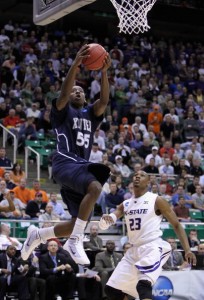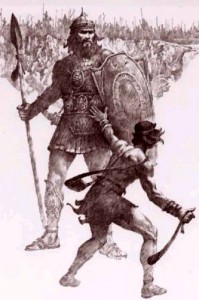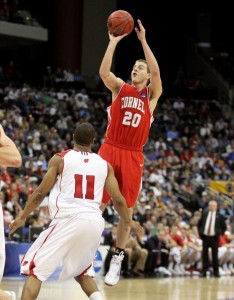Ten-Three-One: The Final Three and the Best of the Rest
Seeding the Underdog Lover’s Best Tournament Ever
The only thing that would have made March Madness an absolute straight flush for underdog fans is Duke losing to Baylor last night. But they came close enough for underdog fans. And this being the tournament in my memory with the most upsets and the most low seeds advancing to the Sweet 16 makes it the Underdog Lover’s best tournament ever.
The great thing about being an underdog fan is that even a nail biter, having to wait until the last minute to know the outcome of a David/Goliath match-up is almost as good as victory.
Now that Duke enters the Final Four as the only surviving one-seed, underdog lovers everywhere can begin focusing our voodoo attacks on a single target and hope to see them crash in the semi’s.
Before going any further with our March Madness analysis, it is necessary to explain the criteria we use to evaluate underdogs in a sort of reverse seeding. In other words, the top seeded dog would be the lowest seeded competitor.
What Makes an Underdog?
There are classic underdogs, and there are relative underdogs. That is why we can only get excited, early in the tournament, about the smaller schools, the long-shots, and the new arrivals.
For the first round we favor “Firsts,” “Worsts,” “Small,” and “The Wall.”
Firsts
First appearance or, lacking this, first in so many years. This year, it was Arkansas Pine Bluff. Of course as the tournament continues the definition of firsts shifts to the point of advance. For instance, Butler has advanced to the Final Four for the first time in history. While they weren’t a tournament first, they are now a first by virtue of surviving to the semi-finals.
Worsts
Lowest seed, lowest RPI ranking, or least difficult schedule. Again, this year it was Arkansas Pine Bluff at the bottom, thus our pre-tournament top.
Small

Xavier pushed Kansas State to double overtime before losing in the "Sweet 16."
Smallest school, smallest market if applicable, small in socio-geographical, demographic-economic status—in other words, from somewhere not frequented by the beautiful people. One of the smallest schools in the tournament this year was Xavier.
The Wall
Up against it, trapped behind it, some sense of being cursed or star-crossed, or a record of failure and disappointment in the Dance if they’ve been there before. Believe it or not, despite their status in the Big East and in virtually every other metric, Syracuse does make our underdog list by this criteria alone. Despite winning one championship, they have come so far, gotten so close so many times, that they could qualify as an underdog depending on who they play. They also tend to get less respect than they deserve, much of the time, from the press and the rankings.
Second Round
In the subsequent rounds, as the pure Cinderellas are eliminated, we move from absolute criteria to the laws of relativity, and the criteria shifts. This year, many true Cinderellas survived to the Sweet Sixteen or the Elite Eight. But as the tournament progresses underdog status becomes more relative and less absolute. At some point, the lowest seed still surviving becomes the highest seeded underdog remaining. But after the first round we move from “Firsts,” “Worsts,” “Small,” and “The Wall,” to “Survivors,” “Drama Queens,” “ Destiny’s Children,” “Luck Strikes,” and “Davids.”
Survivors
The lowest-seed surviving at any point in the tournament becomes our favorite. In the event that it is, as 2008’s disaster, a final four of top seeds, we give up. Short of that, even a No. 2 seed versus a No. 1 seed gets our blessing in most cases. But, we reserve the right to make exceptions.
Drama Queens
Sometimes events during the tournament create an unanticipated Cinderella. It could be some human drama or a daunting comeback capped by a buzzer beater from downtown. We’re always watching for a new dog to emerge.
Destiny’s Children
Similar to the Drama Queens, but different by nuance, are teams that are not seeded in the top two but begin to create a sense of destiny as they progress. By the Sweet Sixteen and beyond, we’ll jump on any bandwagon smelling of destiny.
Lucky Strikes
Some upsets are pure luck. Lucky Strikes this year would include, Murray State, Ohio, Old Dominon, and perhaps Washington.
We celebrate all upsets, and the bigger the upset the more we celebrate, but we prefer upsets that are more strategy than luck. Those come from teams we call “Davids.”
Davids

Every year the NCAA Tournament features a number of matchups between David and Goliath.
Giant killers—you know, like Goliath.
Amazing things happen once the field is whittled down. At this point in the process it has more to do with who we oppose than who we support. The last thing true underdog fans can tolerate is a “predictable” winner.
Our perspective shifts from championing the lowly, to bringing down the mighty. Polls, seeds, and point-spreads all identify the enemy and, by contrast, who we now oppose and who we must support. That being said, sometimes we can have our cake and eat it too. Sometimes the Davids are also original dogs. This year, that would be Cornell and Northern Iowa. As the tournament progressed Butler morphed into David by defeating Syracuse.
Additional Considerations and Tie-Breakers
While we aren’t bound by applying the following criteria, we do some math to use as a corrective to our subjective analysis, and/or to break subjective ties. When looking at a team’s progress through the tournament we subtract the seed of their opponent in each round from the underdog’s seed, and do a reverse credit for actual final point spread between the underdog and the favorite when the underdog is finally defeated. For instance, if a 16 seed beat a one-seed, they would earn 15 points. In the next round if they beat a four-seed they would earn an additional 12 points. If they then lose to a five-seed, they would earn the differential in seed (seven points) and if the final losing score were 70-69 they would lose one point. Their final score would be 33 points. We would consider these scores in making final evaluations but, as already stated, are informed by the values, but not bound by them.
Underdog Seeds: A Dynamic List
Unlike the NCAA brackets where seeding is set and remains static, our seeds change as the competition moves on. As explained above, the first round seeds are determined by the team’s status coming into the tournament. Our final seeds, announced just prior to the Final Four, reflect tournament outcomes prior to the semi-finals.
Given that, I would have to crown Cornell the ultimate Underdog in the tournament. The fact that a team having no scholarships, coming from a league that hasn’t won a NCAA tournament game in 39 years makes Cornell the top seeded underdog this year. Cornell also scores well in the math (“Additional Considerations and Tie-Breakers”).
I was disappointed that more wasn’t said in the analysis of the Cornell/Kentucky game about how well Cornell controlled the pace of the game for a good portion of the game and the fact that after losing a big lead and falling far behind, they battled back to within 6 points late in the game before finally succumbing.
The pundits acted as if they were so relieved that John Calipari’s Wildcats finally turned the basketball world back right side up, that they almost completely ignored how well Big Red managed one of the greatest mismatches in the history of the Elite Eight.
On the same vein, Northern Iowa takes the second underdog seed. Like Cornell, they have no history of success in the tournament. More importantly, like Cornell, they came in with a well-devised strategy for neutralizing the top ranked teams. They, like Cornell, were the sports equivalent of David taking his time selecting five smooth stones for his sling shot before finally taking aim at Goliath. Both Northern Iowa and Cornell were able to win two games with superior strategy against teams with massively superior talent and pre-tournament success.
That leaves Butler and West Virginia among the remaining four. As it is Butler’s first trip in history to the Final Four, adding the fact of their defeating Syracuse, combining their history and their ability to get to the semi’s, they get some extra subjective points. On the other hand, they were a 5th seed in the tournament and have begun to advance in the tournament on a regular basis, so that cancels out the subjective marbles they just earned.
Using the math, Butler comes out somewhat higher than West Virginia but lower than the other underdogs that made noise in this tournament. Therefore, we rank the Bulldogs ninth.
West Virginia, being a member of The Big East, and given the fact that they are a second seed pushes them down to tenth on our final underdog scale..
Thus, our favorites in the Final Four are, first Butler, then West Virginia. If both lose, we may not even watch the championship game.

Representing the non-scholarship Ivy League, Cornell was the ultimate underdog in the 2010 NCAA Tournament.
Here are our Final Underdog Rankings.
1 Cornell
2 Northern Iowa
3 St. Mary’s
4 Washington
5 Murray State
6 Old Dominion
7 Ohio
8 Xavier
9 Butler
10 West Virginia
“But you forgot Michigan State,” someone says.
No, we wish we could have forgotten them. Here’s the deal.
I am ambivalent about Michigan State. They are a large school. As representatives of the Big Ten they also come from one of the “Super Six” conferences that traditionally dominate. They are scholarship laden and talent laden.
True, they come from Michigan, having a sentimental attachment to Detroit, underdog city extrordinaire, given the economics of the auto industry and the ripple effects of their demise that has left Detroit in physical as well as economic ruin. It is also true that Tom Izzo scores underdog points by being the kind of coach who values chemistry over talent and is a master-chemist.
But in spite of that, I still can’t do it. Michigan State only qualifies as an underdog in my scheme by being less than a top seed, and only when they play a higher seeded team. In other words, The Spartans are not intrinsic underdogs. They are relative underdogs. They draw any status they have, relative to their opponent.
Therefore, in a Duke/State match-up, the Spartans, as last year when playing North Carolina, would be our reluctant pick. At the same time, we would watch such a contest with very little enthusiasm—if we watch it at all– and would mourn a Spartan loss less than we would mourn a Duke victory. We’ll seed State as the lowest (for our purposes) of the five seeds in the tournament, making them 45th (of 65) on our underdog scale, in the tournament.
The beauty of this year’s tourney is that never have so many schools ranked so low, achieved so much, with so much disparity in rank. Thus, to wax musical in the vein of Frank Sinatra, the Chairman of the Board, we’ll say,
“In the year, 2010, it was a very good year,
it was a very good year for Cin-der-ellas making the Ball,
and taking it all,
at least more than has been,
in the year 2010.”
